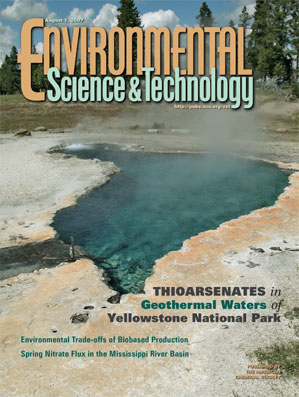 Thioarsenates in Geothermal Waters of Yellowstone National Park: Determination, Preservation, and Geochemical Importance
Thioarsenates in Geothermal Waters of Yellowstone National Park: Determination, Preservation, and Geochemical Importance
BRITTA PLANER-FRIEDRICH, JACQUELINE LONDON, R. BLAINE MCCLESKEY, D. KIRK NORDSTROM, AND DIRK WALLSCHLÄGER
Environmental Science & Technology, 2007
Abstract
Mono-, di-, tri-, and tetrathioarsenate, as well as
methylated arsenic oxy- and thioanions, were determined
besides arsenite and arsenate in geothermal waters of
Yellowstone National Park using anion-exchange chromatography
inductively coupled plasma mass spectrometry.
Retention time match with synthetic standards, measured
S:As ratios, and molecular electrospray mass spectra
support the identification. Acidification was unsuitable for
arsenic species preservation in sulfidic waters, with HCl
addition causing loss of total dissolved arsenic, presumably
by precipitation of arsenic-sulfides. Flash-freezing is
preferred for the preservation of arsenic species for several
weeks. After thawing, samples must be analyzed
immediately. Thioarsenates occurred over a pH range of
2.1 to 9.3 in the geothermal waters. They clearly predominated
under alkaline conditions (up to 83% of total arsenic),
but monothioarsenate also was detected in acidic waters
(up to 34%). Kinetic studies along a drainage channel
showed the importance of thioarsenates for the fate of
arsenic discharged from the sulfidic hot spring. The observed
arsenic speciation changes suggest three separate
reactions: the transformation of trithioarsenate to arsenite
(major initial reaction), the stepwise ligand exchange
from tri- via di- and monothioarsenate to arsenate (minor
reaction), and the oxidation of arsenite to arsenate,
which only becomes quantitatively important after
thioarsenates have disappeared.
NOTE: the article text supplied here is for educational purposes only.
*Don't have Adobe Reader?
Get the latest version.
NOTE: Some versions of Adobe Reader have problems with Google Chrome. Either resize the browser to view the paper or enable
the Chrome internal PDF viewer by entering chrome://plugins in your address bar and clicking enable for the Chrome PDF Viewer plugin.